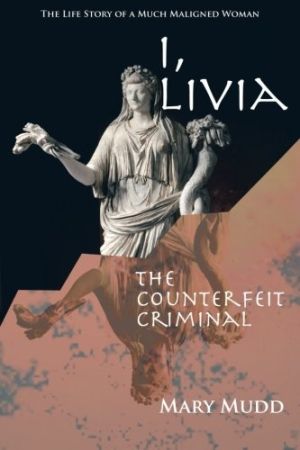I, Livia
The Counterfeit Criminal
History has not been kind to Livia Drusilla, wife of Caesar Augustus, and author Mary Mudd wants to set the record straight in her well-researched book, I, Livia: The Story of a Much Maligned Woman.
“Livia Drusilla has fascinated me ever since, as a geeky, history-obsessed teenager, I read Robert Graves’ [sic] celebrated novel, I, Claudius,” Mudd says. But Graves’s book is also partially responsible for Livia’s historic reputation as a murderess willing to do anything to see her son rise to power. With her research, and knowledge she gained in obtaining a PhD in Roman and Byzantine history, Mudd attempts to disprove these misconceptions.
The meticulous level of research is evident throughout the text. However, a reader with minimal knowledge of Roman history may become perplexed by the number of historical figures presented from the start. Though each person is vital to Livia’s story, confusion comes with the quick pace at which they are introduced. At the end of the text, a chart shows the bloodlines and connections to many of these Roman leaders and their families, but the chart proves slightly unclear due to a muddled layout and limited space. To avoid confusion, Mudd spends the first section of the book narrating Livia’s life—the people she is connected to and the ways she is honored by the people of Rome.
The second section is the most interesting and effective part of the book. In an effort to disprove the claims that Livia murdered anyone who stood in the way of her son’s ascent, the author explains that “scrutiny nevertheless reveals that if Livia perpetrated these tragedies, she wound up worsening conditions for herself and her son.” Mudd takes each accusation against Livia and shows the logic behind why she would not have committed the crime. For example, her two stepsons were killed in their young adulthood; if Livia had murdered them, Mudd asserts, she would likely have done so when they were newborns—the infant mortality rate was very high at that time, so suspicion might never have arisen.
Mudd gives a thorough account of Livia’s relationships with her husband, children, friends, and colleagues, such as Nero, Agrippa, and Julia. This helps solidify the reader’s perception of Livia—that she was, overall, a well-respected and endeared figure: “’[Salome] deferred, not only because … Livia was Caesar’s wife, but because she contributed good advice, in all matters, anyway.’ These words imply that Salome respected Livia as a mentor, in affairs of state, and in private issues as well.”
The author ends with a number of appendices that provide additional information on definitions, historical figures, and art. These pieces are not vital to Mudd’s argument but may help readers better understand the Roman period and the people involved.
In general, this is an interesting read. More attention to punctuation and sentence structure, along with a more methodical introduction of material, would make this an unforgettable book. Mudd’s credentials and the information she presents will win over readers interested in this period of Roman history. But more importantly to the author, readers will see “the living, feeling woman who shared the life and career of the founder of the Roman empire.”
Reviewed by
Kandy Alameda
Disclosure: This article is not an endorsement, but a review. The publisher of this book provided free copies of the book and paid a small fee to have their book reviewed by a professional reviewer. Foreword Reviews and Clarion Reviews make no guarantee that the publisher will receive a positive review. Foreword Magazine, Inc. is disclosing this in accordance with the Federal Trade Commission’s 16 CFR, Part 255.

